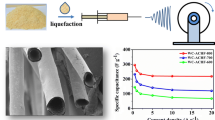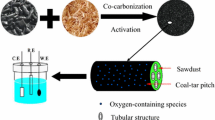Abstract
Activated carbon fibers (ACFs) produced from recycled fir sawdust were used as electrodes in supercapacitors. It was shown that the ultramicropores (0.65–0.85 nm) were most efficient in contributing to the supercapacitor capacitance, while mesopores helped increase the rate performance capacitance. The experimental ACF electrode supercapacitor indicated a capacitance of 242 F g−1 in 6 M KOH aqueous electrolyte exhibiting a high energy density of 8.4 Wh kg−1 at a power density of 250 W kg−1. Excellent cycle stability was also achieved, showing a good competitiveness of wood-based ACFs in comparison with other activated carbons currently used in supercapacitors.








Similar content being viewed by others
References
Dai D, Fan M (2005) Preparation of bio-composite from wood sawdust and gypsum. Ind Crop Prod 74:417–424
Gan Q, Allen SJ, Matthews R (2004) Activation of waste MDF sawdust charcoal and its reactive dye adsorption characteristics. Waste Manag 24:841–848
Paramasivam P, Loke YO (1980) Study of sawdust concrete. Int J Cem Compos Lightweight Concrete 2:57–61
Falcão L, Araújo MEM (2014) Application of ATR-FTIR spectroscopy to the analysis of tannins in historic leathers: the case study of the upholstery from the 19th century Portuguese royal train. Vib Spectrosc 74:98–103
Tymchyshyn M, Xu CC (2010) Liquefaction of bio-mass in hot-compressed water for the production of phenolic compounds. Bioresour Technol 101:2483–2490
Foo KY, Hameed BH (2012) Mesoporous activated carbon from wood sawdust by K2CO3 activation using microwave heating. Bioresour Technol 111:425–432
Pandolfo AG, Hollenkamp AF (2006) Carbon properties and their role in supercapacitors. J Power Sources 157:11–27
Simon P, Gogotsi Y (2008) Materials for electrochemical capacitors. Nat Mater 7:845–854
Burke A (2007) R&D considerations for the performance and application of electrochemical capacitors. Electrochim Acta 53:1083–1091
Hu S, Zhang S, Pan N, Hsieh Y (2014) High energy density supercapacitors from lignin derived submicron activated carbon fibers in aqueous electrolytes. J Power Sources 270:106–112
Ruiz-Fernández M, Alexandre-Franco M, Fernández-González C, Gómez-Serrano V (2011) Development of activated carbon from vine shoots by physical and chemical activation methods. Some insight into activation mechanisms, Adsorption 17:621–629
Olivares-Marín M, Fernández JA, Lázaro MJ, Fernández-González C, Macías-García A, Gómez-Serrano V, Stoeckli F, Centeno TA (2009) Cherry stones as precursor of activated carbons for supercapacitors. Mater Chem Phys 114:323–327
Xie L, Sun G, Su F (2016) Hierarchical porous carbon microtubes derived from willow catkins for supercapacitor applications. J Mater Chem A 4:1637–1646
Feng H, Zheng M, Dong H (2015) Three-dimensional honeycomb-like hierarchically structured carbon for high-performance supercapacitors derived from high-ash-content sewage sludge. J Mater Chem A 3:15225–15234
Alma MH, Yoshioka M, Yao Y, Shiraishi N (1996) Preparation and characterization of the phenolated wood using hydrochloric acid (HCl) as a catalyst, Wood Sci. Technol. 30:39–47
Alma MH, Yoshioka M, Yao Y, Shiraishi N (1995) Preparation of oxalic acid-catalyzed resinified phenloated wood and its characterization. Mokuzai Gakkaishi 41:1122–1131
Liu W, Zhao G (2012) Effect of temperature and time on microstructure and surface functional groups of activated carbon fibers prepared from liquefied wood. BioResources 4:5552–5567
Huang Y, Zhao G (2015) Preparation and characterization of activated carbon fibers from liquefied wood by KOH activation. Holzforschung 70:195–202
Huang Y, Ma E, Zhao G (2015) Thermal and structure analysis on reaction mechanisms during the preparation of activated carbon fibers by KOH activation from liquefied wood-based fibers. Ind Crop Prod 69:447–455
Huang Y, Peng L, Liu Y, Zhao G, Chen JY, Yu G (2016) Biobased nano porous active carbon fibers for high-performance supercapacitors, ACS Appl. Mater. Inter. 8:15205–15215
Tian Z, Zhang W, Lu W (2016) Preparation of nanofibers from phenol liquefied wood by electrospinning. Nanomater, Nanotechno
Huang Y, Ma E, Zhao G (2015) Preparation of liquefied wood-based activated carbon fibers by different activation methods for methylene blue adsorption. RSC Adv 5:70287–70296
Shi H (1996) Activated carbons and double layer capacitance. Electrochim Acta 41:1633–1639
Miyamoto J, Kanoh H, Kaneko K (2005) The addition of mesoporosity to activated carbon fibers by a simple reactivation process. Carbon 43:855–857
Xue R, Yan J, Liu X, Yi Y, Tian B (2011) Effect of activation on the carbon fibers from phenol-formaldehyde resins for electrochemical supercapacitors. J Appl Electrochem 41:1357–1366
Huang Y, Zhao G (2016) A novel method for the production of mesoporous activated carbon fibers from liquefied wood. Mater Lett 178:90–92
Zhao Y, Fang F, Xiao H, Feng W, Xiong L, Fu S (2015) Preparation of pore-size controllable activated carbon fibers from bamboo fibers with superior performance for xenon storage. Chem Eng J 270:528–534
Shimodaira N, Masui A (2002) Raman spectroscopic investigations of activated carbon materials. J Appl Phys 92:902–909
Hu S, Hsieh Y (2014) Preparation of activated carbon and silica particles from rice straw. ACS Sustainable Chem Eng 2:726–734
Kim J, Cho S, Bae T, Lee Y (2014) Enzyme biosensor based on an N-doped activated carbon fiber electrode prepared by a thermal solid-state reaction. Sensor Actuat B-Chem 197:20–27
Hassan MF, Chabot V, Li J, Kim KB, Ricardez-Sandoval L, Yu A (2013) Pyrrolic-structure enriched nitrogen doped graphene for highly efficient next generation supercapacitors. J Mater Chem A 1:2904–2912
Hu Z, Li S, Cheng P, Yu W, Li R, Shao X, Lin W, Yuan D (2016) N, P-co-doped carbon nanowires prepared from bacterial cellulose for supercapacitor. J Mater Sci 51:2627–2633
Taer E, Deraman M, Talib IA, Awitdrus A, Hashmi SA, Umar AA (2011) Preparation of a highly porous binderless activated carbon monolith from rubber wood sawdust by a multi-step activation process for application in supercapacitors. Int J Electrochem Sc 6:3301–3315
Acknowledgements
The authors gratefully acknowledge the financial support from the China National Science & Technology Pillar Program through the Project “Key technology and application demonstration for the production of wood-based functional adsorption materials” (2015BAD14B06) and from China Scholarship Council. Thanks are also extended to Dr. Mourad Krifa and Mr. Hao Wu in the School of Human Ecology at The University of Texas at Austin for their help with the contact angle test and Dr. Guihua Yu and Mr. Lele Peng in the Materials Science and Engineering Program and Department of Mechanical Engineering at The University of Texas at Austin for their help with electrochemical test.
Author information
Authors and Affiliations
Corresponding authors
Rights and permissions
About this article
Cite this article
Huang, Y., Liu, Y., Zhao, G. et al. Sustainable activated carbon fiber from sawdust by reactivation for high-performance supercapacitors. J Mater Sci 52, 478–488 (2017). https://doi.org/10.1007/s10853-016-0347-0
Received:
Accepted:
Published:
Issue Date:
DOI: https://doi.org/10.1007/s10853-016-0347-0




